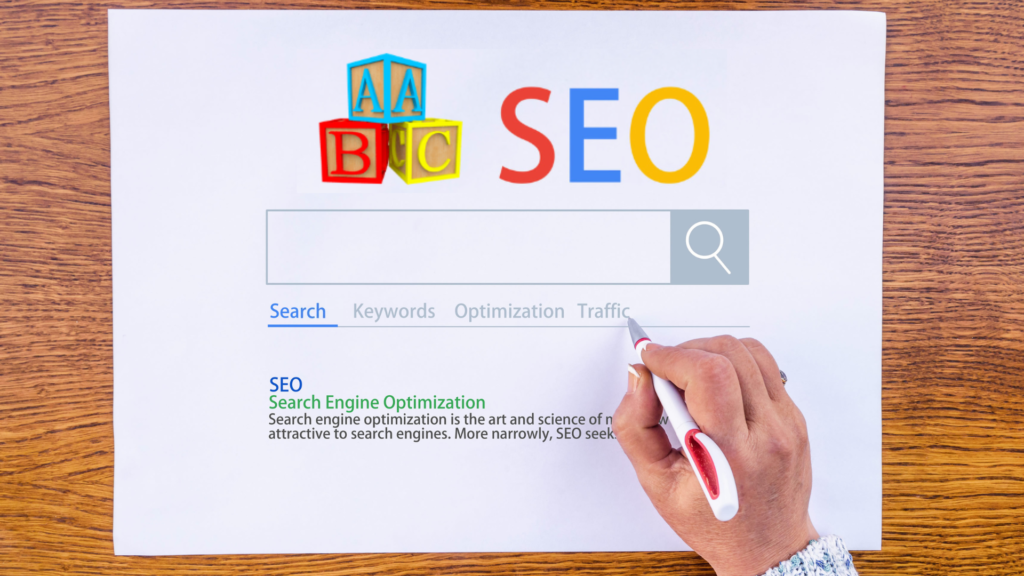The process of search engine optimization (SEO) is often oversimplified as “writing words on a page to rank better on Google.” However, a robust SEO strategy has many facets that push and pull your performance in all different directions. That’s why we’ve created a short list of essential SEO terms that help paint a better picture of on-page, off-page, and technical SEO. Follow along to our list of SEO ABCs (no singing required).
Analytics – A good SEO strategist will use historical data from Google Analytics to help them plan for the start of their SEO strategy. A great SEO strategist will return to Google Analytics on a regular basis to evaluate how well certain optimizations are performing and to find out what areas need to be improved upon next. But, honestly, can you even call it optimization if you don’t incorporate analytics?
Blogging – Writing blogs for your website is a great way to show up in the SERPs while establishing your brand as an authority. Make sure that you aren’t just blogging for the sake of blogging. Find out what your audience is interested in and provide meaningful answers to their questions while integrating keywords that they search for.
Copywriting – Writing great web copy is a core pillar of SEO. Written content should center around key terms and phrases, but try to remember that you’re writing for humans. The best copywriters will write with a mind for both keyword demand and user experience.
Dwell Time – Getting users to your website is all well and good, but how long are they sticking around? Dwell time measures how long a Google Searcher stays on your website before returning to the SERPs, and there’s a great deal of controversy around whether Google uses it algorithmically or not. Regardless, the idea is sound to ensure you’re providing useful content. Try measuring your dwell time to determine how interested users are in your content.
External Links – When other sites link to your site, the search engines take it as a sign that your content is valuable. The best links come from high-quality sites that are topically relevant and must be earned rather than bought or bartered for.
FAQs – Frequently asked questions are a type of rich snippet that help your pages appear more visibly in the search engine results pages. Using FAQs on your site can help you rank for certain questions that people are asking every day. FAQs are only growing in popularity on Google, which in many cases doubles down on FAQ-type content with its “People Also Ask” section. Answering these questions on your website can bring in new users that may convert.
Google’s Algorithm – At the end of the day, a website’s ability to rank is at the mercy of Google’s algorithm. Understanding which activities are beneficial to your site’s performance and which will get you penalized is essential to a successful organic search strategy. Be sure to keep up with Google’s algorithm updates to understand why your pages may rise or fall in the SERPs.
H1 Headings – Make sure all of your web pages are structured with organized headers ahead of your written content. Each page should have at least one H1 heading, but preferably only one. If you have more than one, it’s not the end of the world, as long as you’re not stuffing them with keywords. Make sure to keep your H1 heading focused, include the most important keyword, and try to make it similar thematically to the title tag.
Indexation – After search engines crawl your site, they need to store and rank the pages. That’s where indexing comes into play — without indexation, your pages will never rank. When the content on your pages changes, make sure to submit them for reindexing so Google can see the updates and adjust your rankings accordingly.
JavaScript – Once upon a time, JavaScript code was a major barrier to crawling and indexation. As search engine technology advances, more and more JavaScript is crawlable. Just keep in mind that any links you want to have crawled within the JavaScript code must be coded with anchor tags and should contain anchor text.
Keywords – Discovering the most relevant keywords that have high search volume is the first step to writing content that will boost your rankings while generating relevant traffic and conversions. The words and phrases that people search for will evolve over time, so remember to make updates to your keyword strategy regularly.
Link Internally – Internal linking will help Google understand the hierarchy and relative value of the different pages on your site, and give clues to the keywords you want to rank for. When used well, they’re also a great way to improve user experience and drive customers to your converting pages.
Meta Descriptions – While meta descriptions do not technically affect the keyword relevance or rankings for any given page, they can affect the click-through rate. Meta descriptions should be unique, fall within about 155 characters to avoid truncation, and end with a call to action.
Navigation – The navigation menu is a frequently used tool for users to find different products and services on a website. What we sometimes forget is that Google and other search engines will use your navigation as a map to crawl the site. Use your navigation menu to establish page hierarchy and emphasize the most important pages on the site.
Optimize & Reoptimize – Optimize every page of your website that has value for SEO, and then do it again! Both the content on your site and the demand for certain keywords are always evolving, so make sure to optimize the pages that have the highest value to your SEO program regularly based on organic search performance data.
PPC Collaboration – Paid and organic search shouldn’t be done in a vacuum. The data from paid search can be extremely useful to your SEO program, and vice versa. Use paid ads strategically to increase visibility for keywords you’re having trouble ranking for organically, and SEO to rank for keywords that are too expensive in PPC. And don’t forget to remarket to organic visitors with your PPC ads to generate return visits.
Quality Content – Mindlessly copying and pasting keywords into your content won’t cut it these days. Today, it’s important to write with the customer in mind: What do they need to know, what questions do they have? In many cases, it’s important to write long-form content, always ensuring that every sentence adds value.
Research – Don’t just guess when it comes to what types of content users are interested in or what types of key phrases they’re searching for. Always back up your decisions with data. This means extensive keyword research, competitive research, research into search engine technology, and much more.
Schema Implementation – Schema structured data will help search engines read and classify your content more easily and accurately. Adding schema markup to your website can help Google display rich snippets in your search engine results, making your listings more engaging. To list just a few, this includes business listings, reviews, FAQs, recipes, images, and social media channels.
Title Tags – Sometimes used as the title link — the blue underlined link in Google’s search results — title tags can be the first introduction to your brand that a new user sees when searching on Google. Creating title tags is an art in itself: You only have 55 to 60 characters to state the purpose of the page, include the most important keywords, and state the name of your business.
User-Friendly – Always keep in mind that everything you’re doing on your website is for the user. This includes easy-to-digest content, helpful navigation menus, and fast load times on all types of devices. Keeping your users engaged will help you convert visitors to customers, and keep them coming back for new information or purchases.
Vitals – Google’s core web vitals (CWV) measure some aspects of user experience focused on page speed, interactivity, and stability. The CWV metrics include Largest Contentful Paint, First Input Delay, and Cumulative Layout Shift. Respectively, they represent how quickly the site loads initially, how long it takes to load the first click from the user, and how much a page unexpectedly shifts after loading.
Website – It all starts with your website. Without it, there’s nothing to crawl, index, or rank. Great websites focus on serving a need, whether that’s selling a product, providing a service, or educating visitors on a subject they care about.
XML Sitemap – An XML sitemap is a backend file that helps Google find all of the pages of your website. While they don’t compel search engines to crawl content, they do suggest politely which pages you’d like to have crawled. Make sure they’re free of dead URLs and duplicate content. Keep in mind that an XML sitemap is strictly for search engine consumption, as opposed to an HTML sitemap that helps customers navigate your site.
Year-over-Year – When evaluating organic search performance, using year-over-year data is the best way to remove the effects of seasonality from your analysis. Month-over-month data is also helpful but can give an inaccurate picture when you’re coming into or coming out of a peak season’s performance.
Zero-Click Searches – Not every search results in a click to another site. Recent studies show that a little over half of the searches in Google result in zero clicks, where the searcher either finds their answer directly on the search engine results page or chooses not to click for some other reason. These are becoming more and more frequent, so try to optimize your search results so that your pages appear in as many locations as possible — PPC, rich snippets, Google My Business, image search, shopping, and more.
It’s hard enough to understand SEO without understanding the terminology. Hopefully, these ABCs of SEO have shed some light on several new areas you can research to improve your SEO game.
This content was originally published here.




